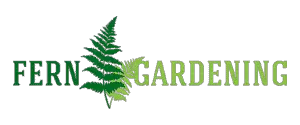Ferns are popular houseplants, because they are well suited to the indoor environment and come in many beautiful forms. They are distinctive too, in that the principal pleasure in a fern comes from the evergreen foliage rather than a short-lived flower. But, given the wide range of varieties, how do you choose the best fern for your house?
Indoor ferns can be selected for different characteristics – how easy they are to look after, how eye-catching or unusual they are, or simply how beautiful the foliage is. Here are twelve of the best indoor ferns, with a bonus at the end of the many varieties of the classic Boston fern.
The best choice for you will of course depend on your own situation, both in terms of the impact you would like the fern to make, and how much time you can spare for maintaining a variety that needs more care.
As a first note, the general rules for ferns are quite simple: if you keep the soil moist but not waterlogged, and place the fern away from direct sunlight and drafts, you are likely to have successful growth. Some varieties need special care that goes beyond these straightforward rules, but most are resilient and reliable once established.
With those points out of the way, let’s start the list. First up, if you want to enjoy the best that ferns have to offer with the minimum of fuss, here are some great choices:
Low maintenance ferns
First up is the rabbit’s foot fern. This variety has delicate fronds that have that lacy fern style, but also have striking hairy rhizomes (root stems) that weave around the base of the plant and often overhang the rim of the pot. These fluffy rhizomes are what give the fern its name.
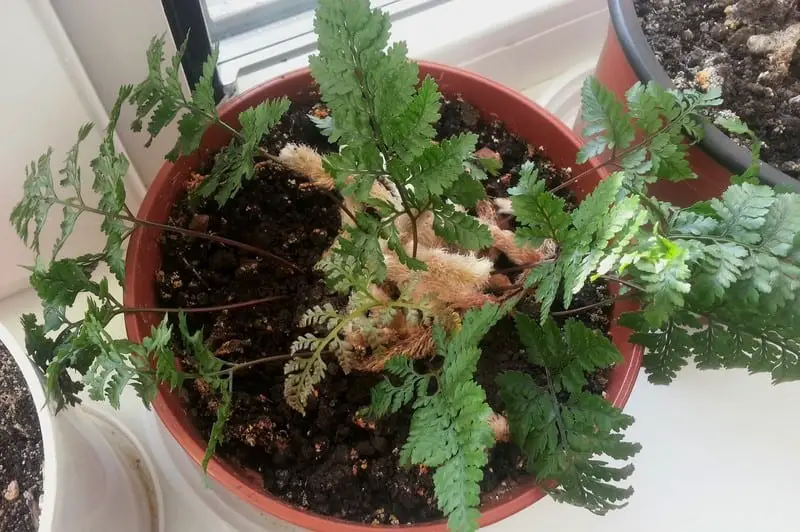
Rabbit’s foot fern
- Davallia solida (var. fejeensis)
- Evergreen
- Partial shade
- Height: up to 1 m
- Soil: acid or neutral. Moist, well-drained.
Rabbit’s foot ferns are easy to care for, being tolerant of occasional overwatering or underwatering by busy owners. They are also good for mid-range light levels, so suitable to most parts of the house, except windowsills.
Second is the Bird’s nest fern. With striking glossy leaves, and an open, eye-catching crown, this variety doesn’t look like a classic fern, but has its own appeal nonetheless.
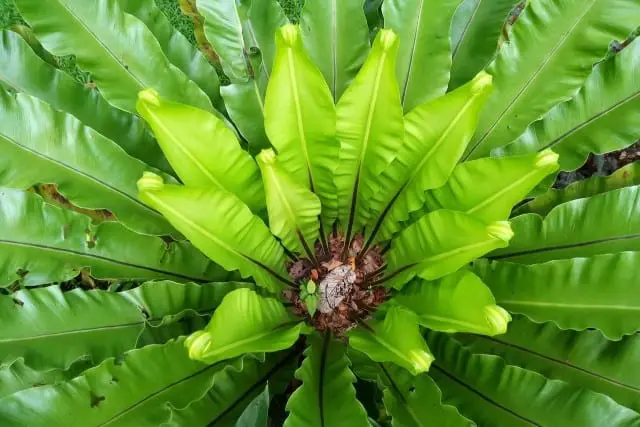
Bird’s nest fern
- Asplenium nidus
- Evergreen
- Partial or full shade
- Height: up to 1 m
- Soil: acid or neutral. Moist, well-drained.
The Bird’s nest fern is relatively drought-tolerant, so forgiving of occasional forgetfulness. Bird’s nest ferns are “epiphytic” or air plants that grow on the side of trees or logs in natural environments, getting by on the nutrients from rainwater that collects in its nest-like crown. But they grow avidly in pots too, and are a popular choice for a houseplant.
Next is an eye-catching variety called the Kangaroo paw fern.
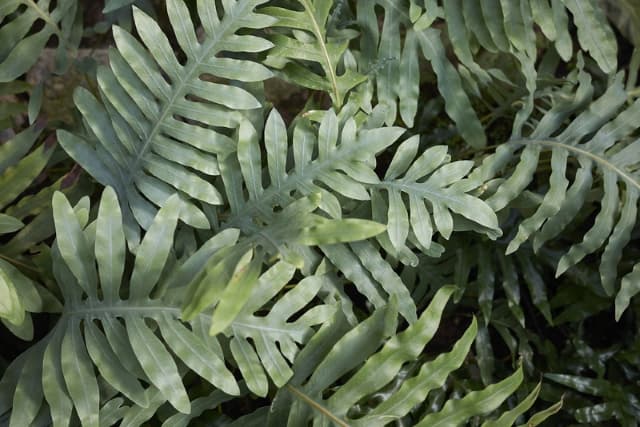
Kangaroo paw fern
- Microsorum diversifolium
- Evergreen
- Prefers partial shade
- Height: up to 0.5 m
- Soil: acid or neutral. Moist, well-drained.
This also has large, distinctive, dark green fronds that apparently resemble kangaroo paws (maybe if you squint at them just right?). These ferns originate from Australia and New Zealand, and are tolerant of dry air and occasional underwatering. They can put on a lot of growth, and form a cascade of fronds that hangs from the pot. As well as the lush foliage, they can also grow a tangle of rhizomes that decorate the base of the fern and often escape the pot too.
Finally, another very forgiving variety of fern is common Polypody, or Adder’s fern.
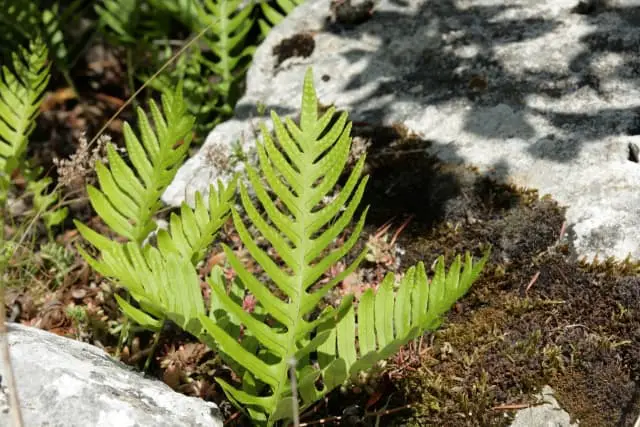
Common polypody
- Polypodium vulgare
- Evergreen
- Partial shade or full sun
- Height: up to 0.5 m
- Soil: Neutral or alkaline. Moist, well-drained.
It is able to cope with wet or dry conditions, and can also tolerate full sun (but best to keep it well watered if you place it in a sunny spot).
Unusual ferns
For those looking for something a little different, there are some ferns that thrive as indoor plants that have some striking and unusual features.
One of the most popular “weird” ferns is the Staghorn fern.
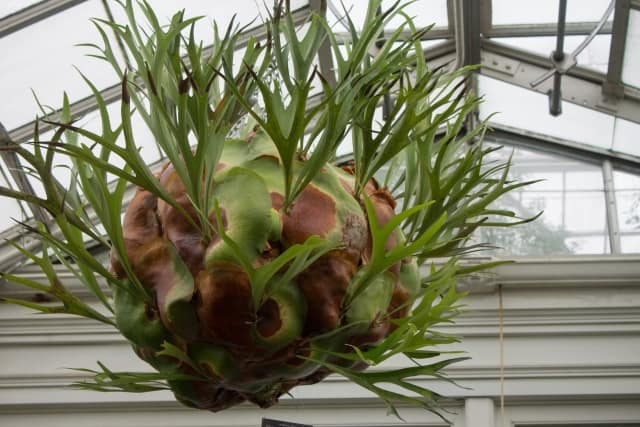
Staghorn fern
- Platycerium bifurcatum
- Evergreen
- Prefers partial shade
- Height: up to 1 m
- Epiphytic (but can be grown on loam). Keep moist, well-drained.
This can be grown mounted to a board or in a hanging basket, and has distinctive multi-pronged fronds that hang down from the plate-like shield fronds that help anchor the fern to its surface. Like the bird’s nest fern, Staghorns are epiphytes and so need minimal soil or feeding. Occasional soaking in water is recommended to maintain good health, or regular misting to keep humidity levels up.
Sticking with the theme of unusual frond shapes – the Heart (or Heart leaf) fern has lovely glossy, waxy fronds that stand proud on wiry black stems, and are shaped like a heart or arrowhead.
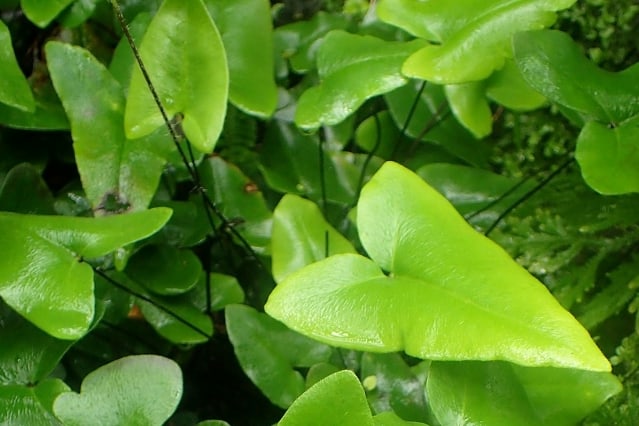
Heart fern
- Hemionitis arifolia
- Evergreen
- Prefers partial shade or indirect light
- Height: up to 0.5 m
- Soil: neutral. Moist, well-drained.
Image credit: Krzysztof Ziarnek
These can be trickier ferns to maintain, needing lower light levels and high humidity as well as warm conditions. But if you get the conditions right, you will be rewarded by a highly unusual fern with uniquely patterned fronds.
Next is a broad-leafed fern with undivided fronds, the Crocodile fern. This is a more robust variety that copes with occasional dry spells, and is less demanding than the Heart fern. It is notable for the striking patterned surface to the fronds that resembles crocodile skin.
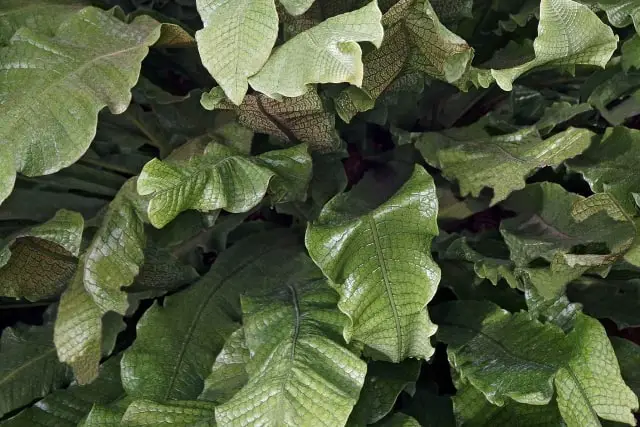
Crocodile fern
- Microsorum musifolium
- Evergreen
- Partial to full shade
- Height: up to 1 m
- Soil: Acid or neutral. Moist, well-drained.
It can put on a lot of growth and give a very dramatic display.
Finally, the Lemon button fern is another popular choice that is unusual by virtue of being scented (at least during the growing season when new foliage is emerging).
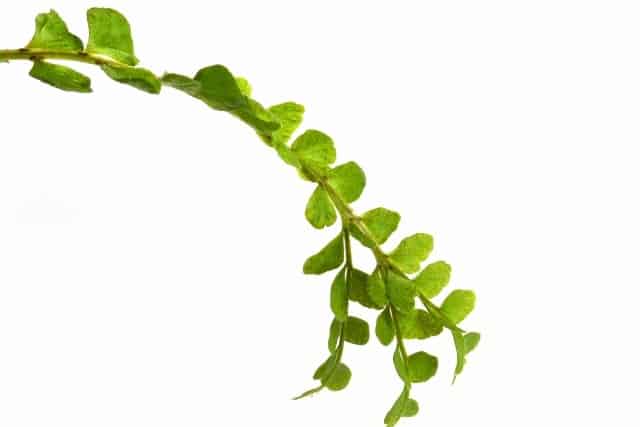
Lemon button fern
- Nephrolepis cordifolia (duffii)
- Evergreen
- Partial shade
- Height: up to 0.5 m
- Soil: acid or neutral. Moist, well-drained.
As the name suggests, this fern has a faint lemony aroma that is subtle and attractive. It also has lovely delicate, rounded fronds on long stems, somewhat similar to a maidenhair fern.
Beautiful ferns
That brings us to the ferns most noted for their beauty.
Maidenhair ferns are rightly famed for the shower of delicate fronds on dark stems that form a bushy display that falls over the sides of the pot like waterfalls.
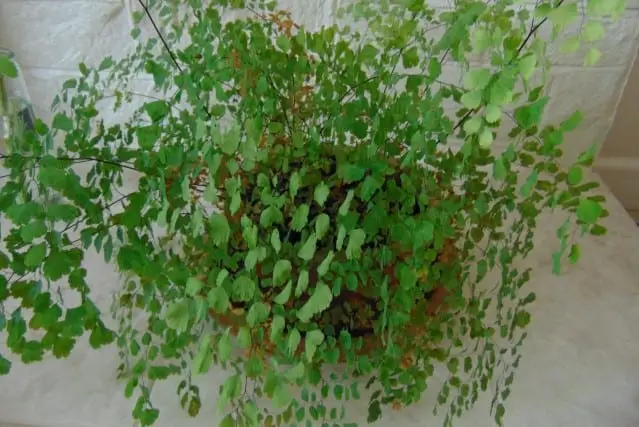
Maidenhair fern
- Adiantum raddianum
- Evergreen
- Partial shade
- Height: up to 0.5 m
- Soil: neutral or alkaline. Moist, well-drained.
They are very popular because of this aethestic appeal, but also notoriously tricky to maintain. Maidenhair ferns need well watered soil, but can also fall prey to root rot if waterlogged. They also need middling light levels – not too bright or too dark.
Despite this fussiness, many people consider them worth the effort, and a robust and healthy maidenhair fern is undoubtedly a thing of beauty.
Next up in the “prettiness” category is the Japanese painted fern. These ferns are normally grown outside as they are cold hardy and so thrive in the garden, but the delicacy and elegance of their patterned fronds can also be enjoyed indoors.
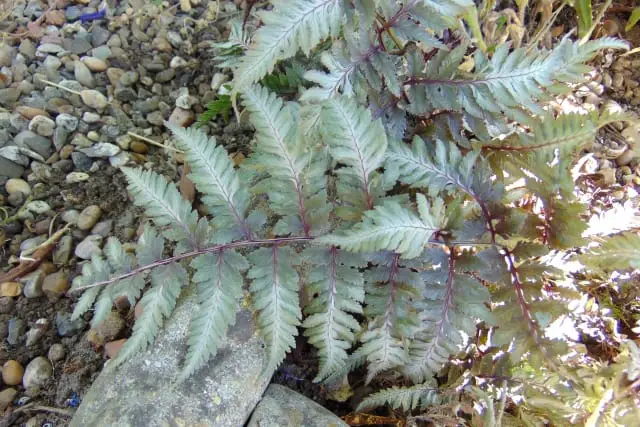
Japanese painted fern
- Athyrium niponicum
- Deciduous
- Prefers partial shade
- Height: up to 0.5 m
- Soil: acid, neutral or alkaline. Moist, well-drained.
There are several cultivars of the Japanese painted ferns that vary in their coloration and frond shape. A good nursery would be able to offer some choice.
Finally, another delicate and beautiful fern is the variegated Silver brake fern.
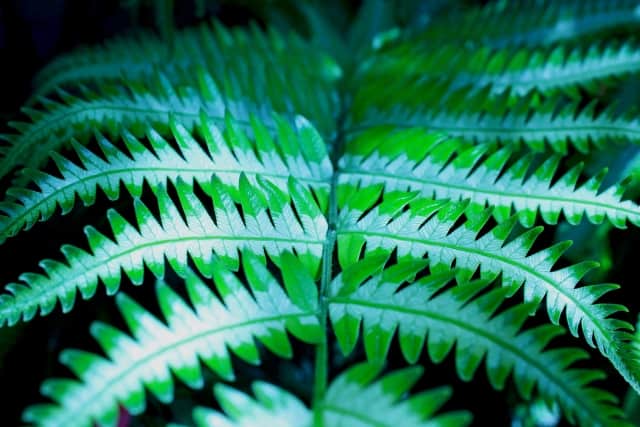
Silver brake fern
- Pteris argyraea
- Evergreen
- Prefers partial shade
- Height: up to 0.5 m
- Soil: acid or neutral. Moist, well-drained.
Less common than the other varieties, it is nonetheless an attractive and appealing fern. Other similar brake ferns (such as Pteris cretica and Pteris ensiformis ‘Victoriae’) are also variegated, and so if the two-tone color is a draw for you, there is a range of options available.
The many varieties of Boston fern
No list of popular indoor ferns could be complete without the Boston fern.
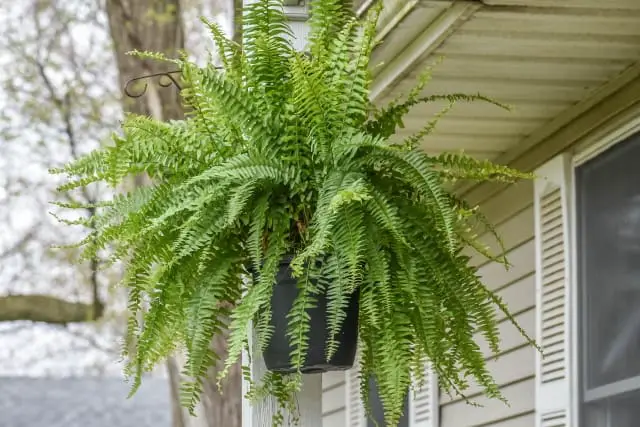
Boston fern
- Nephrolepis exaltata
- Evergreen
- Partial shade
- Height: up to 1 m
- Soil: acid or neutral. Moist, well-drained.
This is the archetypal indoor variety – popular, fairly easy to maintain, and exuberant in its growth. Boston ferns have long, dangling fronds with the classic fern “pinnate” style and make it ideal for hanging baskets.
Because of its perennial popularity, the growers and breeders have been busy over the years and developed many varieties and cultivars of the Boston that provide more flexibility for growth conditions or more visual appeal, or quirkiness. If you are looking for a Boston fern try exploring some of these options:
The Tiger fern has large, subtly variegated fronds and a similar growth style to the classic Boston fern. The Dallas fern is more tolerant of dry spells and high temperatures. ‘Kimberley Queen’ is another variety that can tolerate lower humidity – which is useful for the average household.
‘Rita’s gold’ has striking pale green fronds (especially the new growth) that almost looks golden. ‘Cotton candy’ and ‘Fluffy ruffles’ varieties are noted for their peculiar frond shapes, being more compact and finely divided than the original Boston fern.
This catalog of options helps illustrate a last note: even within each species of fern there are often multiple varieties and cultivars that add another level of flexibility for finding the ideal specimen.
Overall, there is an abundance of choice when it comes to selecting an indoor fern. Take a moment to consider the location where you want to place your fern, and your priorities (ease, distinctiveness or beauty) when it comes to the final result, and then explore all the wide range of varieties and cultivars out there to find the perfect match to your home.
